Raevenlord
News Editor
- Joined
- Aug 12, 2016
- Messages
- 3,755 (1.24/day)
- Location
- Portugal
| System Name | The Ryzening |
|---|---|
| Processor | AMD Ryzen 9 5900X |
| Motherboard | MSI X570 MAG TOMAHAWK |
| Cooling | Lian Li Galahad 360mm AIO |
| Memory | 32 GB G.Skill Trident Z F4-3733 (4x 8 GB) |
| Video Card(s) | Gigabyte RTX 3070 Ti |
| Storage | Boot: Transcend MTE220S 2TB, Kintson A2000 1TB, Seagate Firewolf Pro 14 TB |
| Display(s) | Acer Nitro VG270UP (1440p 144 Hz IPS) |
| Case | Lian Li O11DX Dynamic White |
| Audio Device(s) | iFi Audio Zen DAC |
| Power Supply | Seasonic Focus+ 750 W |
| Mouse | Cooler Master Masterkeys Lite L |
| Keyboard | Cooler Master Masterkeys Lite L |
| Software | Windows 10 x64 |
Intel's Optane products, based on the joint venture with Micron, have been hailed as the next step in memory technology - delivering, according to Intel's own pre-launch slides, a mid-tier, al-dente point between DRAM's performance and NAND's density and pricing. Intel even demoed their most avant-garde product in recent times (arguably, of course) - the 3D XPoint DIMM SSD. Essentially, a new storage contraption that would occupy vacant DIMM channels, delivering yet another tier of storage up for grabs for speed and space-hungry applications - accelerating workloads that would otherwise become constrained by the SATA or even NVMe protocol towards NAND drives.
Of course, that product was a way off; and that product still hasn't come to light. The marriage of Optane's density and speed with a users' DRAM subsystem is just wishful thinking at best, and the dreams of pairing DRAM and 3D Xpoint in the same memory subsystem and extracting the best of both worlds remains, well... A figment of the imagination. But not according to some retailers' websites, though. Apparently, the usage of Intel's Optane products as DRAM memory has already surfaced for some vendors - Dell and HP included. How strange, then, that this didn't come out with adequate pomp and circumstance.
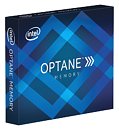
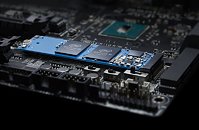

Well, the reason for that is simple. There's no real new Optane DIMM product blurring the line in select laptop systems from both those makers. The thing that's happening here is, at best, a naive error from retailers' part, and at worst, a full-blown effort from Intel and its partners to take advantage of the not so tech-savy consumers - a blasphemy that never happened before, granted. Retailers are basically picking their in-built Optane drives' capacities and merge them with the system's DRAM pool - hence, as in the Dell product result below, total system memory appears at the 24 GB mark. Incredible that a under $1000 system packs that amount of DRAM, when pricing of that particular PC component still is what it is.
In reality, though, and you might have seen this coming, not all of it is DRAM - those 24 GB are made out of a 16 GB Optane Cache SSD and 8 GB of DDR4. And there's a slight - a huge difference, really - in performance between both solutions. The same is repeated in regards to a HP laptop - which is touted as having "24 GB memory" - again, an 8 GB DRAM + 16 GB Optane configuration. HP's mistake seems more innocent than originally reported - the company correctly separates the "memory" concept (which come on, is really vague to begin with) from Intel's Optane - so there's that. But Dell doesn't - the company sums up the two amounts of memory as if they were interchangeable, and that's it. And I distinctly remember my father telling me, not so long ago, that his public-servant, workplace computer had 1 TB of RAM memory. And this happens with clear-cut memory distinctions such as HDD and DRAM - what did these companies really expect with this indiscriminate lumping of system memory? Well, perhaps increased product awareness from users that look at 24 GB of system memory on an Intel system, compare with an AMD one's feeble 8 GB of DDR4 RAM, and opt for the bigger number? Again - it's not like that's likely the majority of the market's thinking, is it?


Of course, this could all be chalked up to two OEMs' (well, more Dell than HP, as we've seen) zealot interpretation of Intel's Optane products as the last cookie in the jar. However, one has to take into account that Intel dominates its marketing department and message with a steel demeanor; the company wouldn't want its products to be mishandled by OEM makers. The idea in this Optane push, one guesses, is that it helps Intel move Optane cache drives still in stock (writing-off hardware is a costly affair, as we know, and Optane bundles are a dime a dozen now). This also allows for a one-upper against the competition in the amount of system memory that's displayed, deviously or not - competition that lacks support for Optane in the first place, let's not forget.
This might have looked like a blatant hit piece on Intel were it not for how the company changed they way it presents Optane memory in its FAQ sheets - from June 2017 to the last May 2018 revision, some truths became muddy, and the overall Intel approach to the separation between Optane (in its current M.2 cache drive implementation, which is what we're talking about) and DRAM became less clear. Namely, it went from: "The Intel Optane memory module does not replace DRAM" to "Intel Optane memory is called memory because it uses a new memory media to store information closer to the processor. It's similar to the function of dynamic random access memory (DRAM)." Which could be justified if the underlying technology had seen some advancements that warranted that, getting it closer to DRAM - but it hasn't.
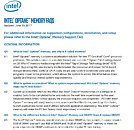

Well, false - the memory and cache hierarchy that Intel started doing its presentations at first, in a triangular shape, now have become a horizontal affair with a "hot" and "cold" codification for super duper best memory (DRAM) and the worst possible (according to Intel, erm, NAND?) That's an improvement in terms if I've ever seen one. In all seriousness, even if the product lineup did change and Optane DIMMs in the form of the Intel Optane DC persistent memory had already been launched to market, thus blurring the line between system memory and DRAM, the question remains of whether users - and particularly laptop users - will want that product in their machines. With laptop designs being what they are, DIMM slots will be served up in up to two per laptop - which leaves either two for DRAM modules (the best configuration, so as to take advantage of dual-channel performance), or a single DRAM module and one Intel Optane DIMM solution. Performance of that is yet to come, but we have to wonder whether the trade-off is worth it in bandwidth-intensive scenarios, especially integrated graphics performance (which uses system RAM as graphics framebuffer).
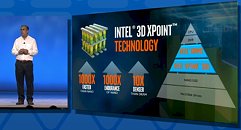
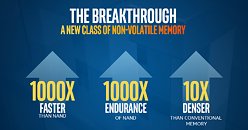
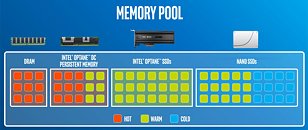
Of course, there's not really fire that we can touch and burn ourselves with in this subject right now - this is all a matter of smoke signals and what seems to be a strange correlation of events between Intel changing its FAQ sheets, the Optane bundle push with the company's own CPUs and partner motherboards, and Intel's OEM partners beginning to create "memory" aberrations out of DRAM and Optane cache drives. Intel's FAQ changes seem to point towards a creating a somewhat misty environment that allowed for a mixed message from its OEM partners, thus allowing for more Optane drives to be bundled in more attractive ways in different systems. Of course, we could all be wrong about this. Or we could not be - there have been mean, green, anti-consumer things happening relatively recently. Maybe that gave Intel the blues?
In the meantime, I'll search for laptops with 40 GB of system memory.
View at TechPowerUp Main Site
Of course, that product was a way off; and that product still hasn't come to light. The marriage of Optane's density and speed with a users' DRAM subsystem is just wishful thinking at best, and the dreams of pairing DRAM and 3D Xpoint in the same memory subsystem and extracting the best of both worlds remains, well... A figment of the imagination. But not according to some retailers' websites, though. Apparently, the usage of Intel's Optane products as DRAM memory has already surfaced for some vendors - Dell and HP included. How strange, then, that this didn't come out with adequate pomp and circumstance.



Well, the reason for that is simple. There's no real new Optane DIMM product blurring the line in select laptop systems from both those makers. The thing that's happening here is, at best, a naive error from retailers' part, and at worst, a full-blown effort from Intel and its partners to take advantage of the not so tech-savy consumers - a blasphemy that never happened before, granted. Retailers are basically picking their in-built Optane drives' capacities and merge them with the system's DRAM pool - hence, as in the Dell product result below, total system memory appears at the 24 GB mark. Incredible that a under $1000 system packs that amount of DRAM, when pricing of that particular PC component still is what it is.
In reality, though, and you might have seen this coming, not all of it is DRAM - those 24 GB are made out of a 16 GB Optane Cache SSD and 8 GB of DDR4. And there's a slight - a huge difference, really - in performance between both solutions. The same is repeated in regards to a HP laptop - which is touted as having "24 GB memory" - again, an 8 GB DRAM + 16 GB Optane configuration. HP's mistake seems more innocent than originally reported - the company correctly separates the "memory" concept (which come on, is really vague to begin with) from Intel's Optane - so there's that. But Dell doesn't - the company sums up the two amounts of memory as if they were interchangeable, and that's it. And I distinctly remember my father telling me, not so long ago, that his public-servant, workplace computer had 1 TB of RAM memory. And this happens with clear-cut memory distinctions such as HDD and DRAM - what did these companies really expect with this indiscriminate lumping of system memory? Well, perhaps increased product awareness from users that look at 24 GB of system memory on an Intel system, compare with an AMD one's feeble 8 GB of DDR4 RAM, and opt for the bigger number? Again - it's not like that's likely the majority of the market's thinking, is it?


Of course, this could all be chalked up to two OEMs' (well, more Dell than HP, as we've seen) zealot interpretation of Intel's Optane products as the last cookie in the jar. However, one has to take into account that Intel dominates its marketing department and message with a steel demeanor; the company wouldn't want its products to be mishandled by OEM makers. The idea in this Optane push, one guesses, is that it helps Intel move Optane cache drives still in stock (writing-off hardware is a costly affair, as we know, and Optane bundles are a dime a dozen now). This also allows for a one-upper against the competition in the amount of system memory that's displayed, deviously or not - competition that lacks support for Optane in the first place, let's not forget.
This might have looked like a blatant hit piece on Intel were it not for how the company changed they way it presents Optane memory in its FAQ sheets - from June 2017 to the last May 2018 revision, some truths became muddy, and the overall Intel approach to the separation between Optane (in its current M.2 cache drive implementation, which is what we're talking about) and DRAM became less clear. Namely, it went from: "The Intel Optane memory module does not replace DRAM" to "Intel Optane memory is called memory because it uses a new memory media to store information closer to the processor. It's similar to the function of dynamic random access memory (DRAM)." Which could be justified if the underlying technology had seen some advancements that warranted that, getting it closer to DRAM - but it hasn't.


Well, false - the memory and cache hierarchy that Intel started doing its presentations at first, in a triangular shape, now have become a horizontal affair with a "hot" and "cold" codification for super duper best memory (DRAM) and the worst possible (according to Intel, erm, NAND?) That's an improvement in terms if I've ever seen one. In all seriousness, even if the product lineup did change and Optane DIMMs in the form of the Intel Optane DC persistent memory had already been launched to market, thus blurring the line between system memory and DRAM, the question remains of whether users - and particularly laptop users - will want that product in their machines. With laptop designs being what they are, DIMM slots will be served up in up to two per laptop - which leaves either two for DRAM modules (the best configuration, so as to take advantage of dual-channel performance), or a single DRAM module and one Intel Optane DIMM solution. Performance of that is yet to come, but we have to wonder whether the trade-off is worth it in bandwidth-intensive scenarios, especially integrated graphics performance (which uses system RAM as graphics framebuffer).



Of course, there's not really fire that we can touch and burn ourselves with in this subject right now - this is all a matter of smoke signals and what seems to be a strange correlation of events between Intel changing its FAQ sheets, the Optane bundle push with the company's own CPUs and partner motherboards, and Intel's OEM partners beginning to create "memory" aberrations out of DRAM and Optane cache drives. Intel's FAQ changes seem to point towards a creating a somewhat misty environment that allowed for a mixed message from its OEM partners, thus allowing for more Optane drives to be bundled in more attractive ways in different systems. Of course, we could all be wrong about this. Or we could not be - there have been mean, green, anti-consumer things happening relatively recently. Maybe that gave Intel the blues?
In the meantime, I'll search for laptops with 40 GB of system memory.
View at TechPowerUp Main Site




